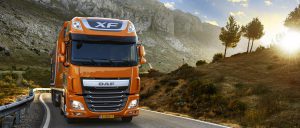
Our Speaker this week, our very own member Peter Jackson, clearly had a spring in his step. His daughter-in-law, Julia, had just given delivery to a baby boy, Albert Joseph, weighing in at 5lbs 4oz. But proud Granddad was about to captivate us with a talk about something rather weightier: Heavy Goods Vehicles (HGV) weighing up to 40 tonnes together with their lighter sisters (all Stobart vehicles have female names).
Peter commenced his talk by giving us a brief resume of his journey through life so far. A Sheffield lad born in the Old Jessop’s Hospital on the 3rd July 1948. Educated at Wrekin College on the Welsh border. He felt that his academic education-especially chemistry- had been ‘good’ but the careers advice ‘could do better’.
As the motorway system developed during the ‘sixties freight was shifting from rail to road and vehicles becoming larger. Moving with the times, Peter was inspired to become not a train engine driver but an HGV driver, an ambition encouraged neither by his school or his parents. After one or two minor jobs –including one in a brewery- Peter found his milieu. He secured employment in 1975 with DAF Trucks GB Ltd which was to absorb Leyland Trucks in 1987 and become the DAF organisation we know today where almost all DAFs in the UK are built at the Leyland plant. Over the next 25 years he worked his way up from what he described as a ‘Tea boy’ to Bus, Military and Government Sales Director.
During these years Peter absorbed both technical and commercial knowledge equipping him for a higher aspiration: he was to start his own driver training business econoDrive in 2000. With the road transport industry facing increasing environmental, safety, efficiency and legislative requirements demand was growing (and continues to grow) to improve both driver compliance and competence operating increasingly sophisticated and expensive vehicles.
Our speaker moved on to the meat of his talk: the vehicles and their fuel. Was the Diesel car dead? He asked. Peter thought that depended on its application: The size and weight of vehicle, the distances to be covered and the type of use.
The Controversy over particulate pollution (soot) was growing along with the number of diesel vehicles on the road. The issues were confusing: encouraged by legislation in the 1990s 50% of new cars are now powered by diesel and virtually all HGVs. But while cars had increased from 4 million in 1970 to over 36 million today, there are, thanks to greater efficiency, actually a third less (at 450K) HGVs (excluding buses). The shift from petrol had been officially encouraged by tax incentives (to be withdrawn from April when most vehicles will have to pay a minimum of £140 annually) to address concerns over burning fossil fuels and Carbon Dioxide emissions creating a hole in the ozone layer.
There was increasing scientific evidence which showed these were contributing to global warming while the issue had become the subject of International agreements. But the debate had shifted to the impact of soot from burning Diesel and the associated Oxides of Nitrogen (known collectively as NOx) on air quality, particularly in congested cities, a subject highlighted by the VW scandal. All this was to lead to the present development of hybrid (usually petrol/electric) and electric battery powered vehicles. Leaving aside current (highly subsidized) cost even these had their disadvantages: their dependence on Lithium (a material in very short supply and with limited sources) batteries which required regular and accessible charging facilities, aside from their as yet unknown life cycle.
Peter went on to outline the theories behind various types of engine and their fuels. I am afraid that possessing, I am ashamed to admit, only an ‘O’ Level in General science the chemical equations showing the molecular constructions of fuel compounds were rather beyond me! Peter had had to consult his old Chemistry teacher (still alive) to understand them. We were showed a number of video clips which including one which explained the technicalities of various types of engine and especially how fuel is converted into the horse power which thrust a vehicle. Another showed the effects of adding “Ad Blue” to diesel fuel to reduce NOx. One video showed lighted matches being dropped into bowls of petrol and diesel to illustrate their different combustions: not to be tried at home! Another explained how diesel is vaporised under pressure to encourage combustion, and yet another the developing scene in self -controlled or driver-less vehicles.
Finally, we came to the crunch when shown the effects of a serious collision which radar control (Autonomous Emergency braking System – AEBS) is seeking to prevent.
All this research has been stimulated in recent years by a series of six European directives, in turn driven by environmental and, at times, fuel sourcing concerns. Developments, both now and in the future, such as the Electronic Stability Programme (ESP), Adaptive Cruise Control (ACC) and Advanced Emergency Breaking (AEBS) and other research has had much of its initial application to heavy vehicles but is being increasingly applied to cars, driver-less or otherwise.
Peter helpfully concluded by giving some advice to members thinking of buying a new car:
- Diesel, with its higher mpg, for frequent long or continuous running which keeps the exhaust system hot and therefore cleans the emissions
- Hybrid or petrol for medium distances
- Electric for short or stop start journeys round the town
Peter was warmly thanked by our Chairman for his most interesting talk which, as stand in, he had finished preparing at 4am. Perhaps Eddie Stobart should give the boy(s) some recognition and name one of his vehicles Peter Jackson!
